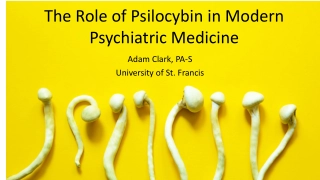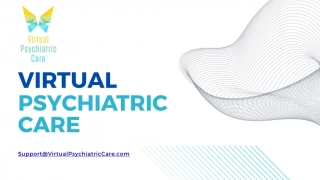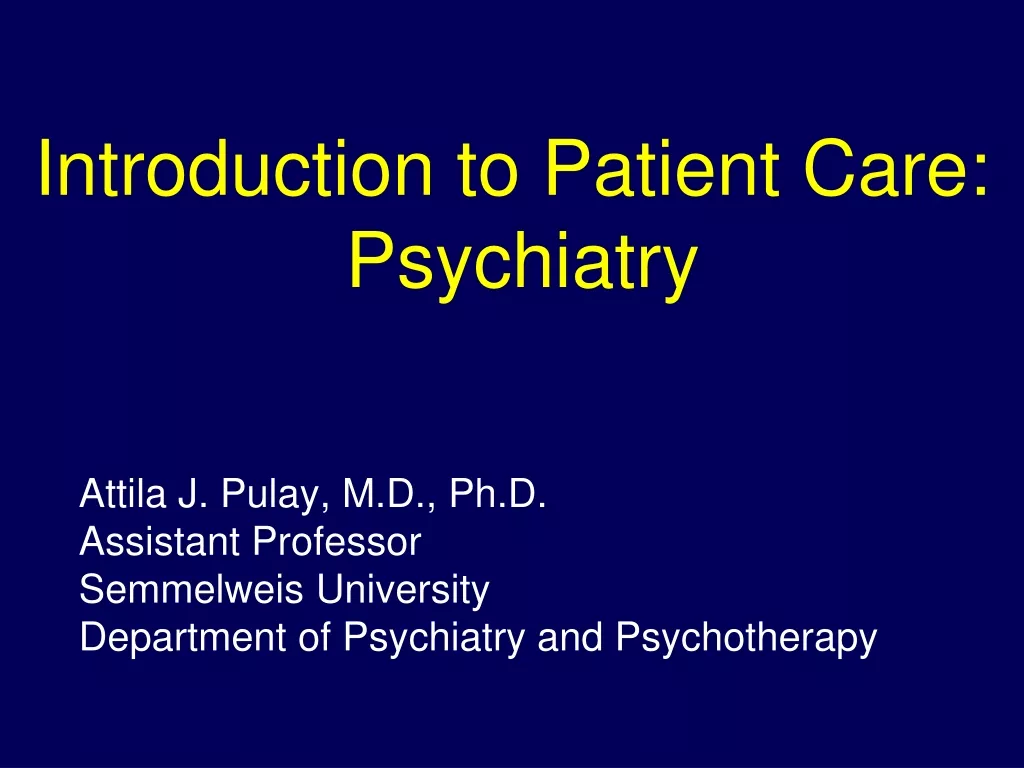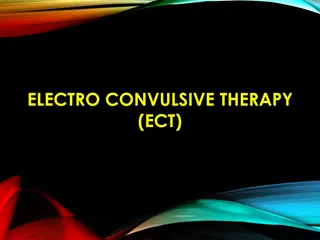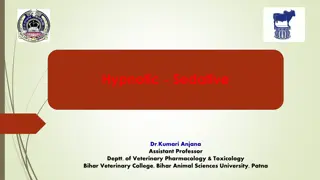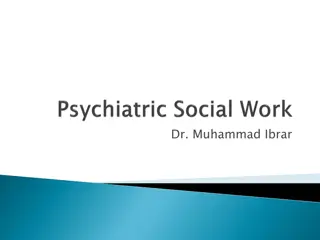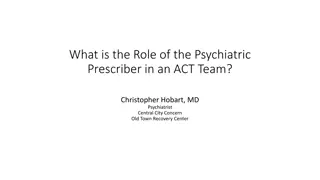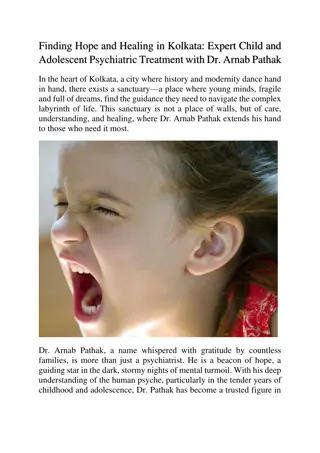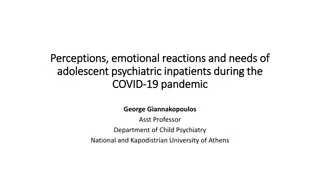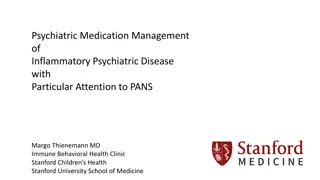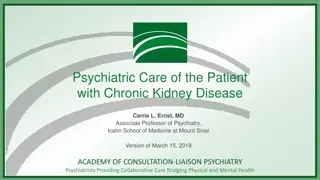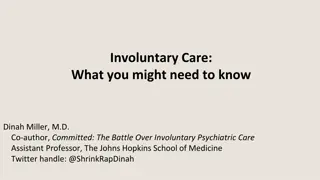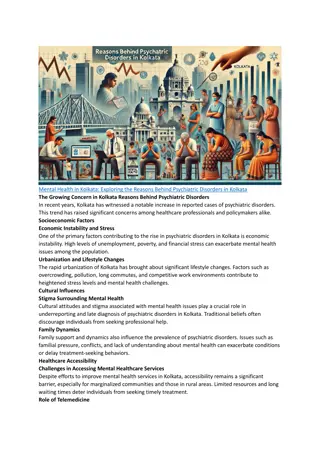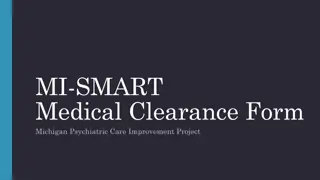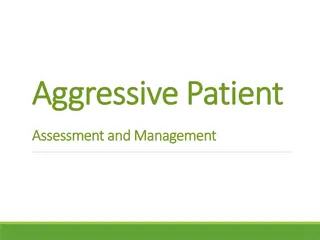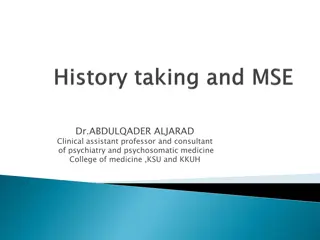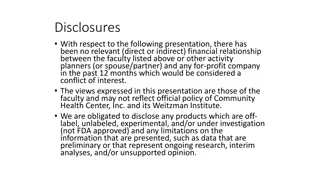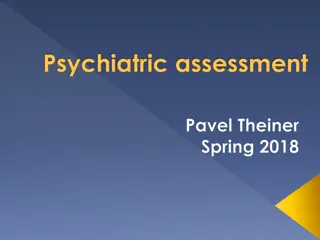Overview of Psychiatric Pharmacology: A Comprehensive Guide from 2013
This presentation delves into the nuances of psychiatric pharmacology, exploring common psychiatric conditions, historical perspectives on medical treatments, categories of psychiatric medications, and principles of treatment. It also touches on mental illness definitions from DSM-IV-TR and DSM-V, as well as specific disorders like psychotic disorders, mood disorders, and anxiety disorders. The content sheds light on substance and personality disorders, offering insights into somatic treatments and the evolving landscape of psychiatric care.
Download Presentation

Please find below an Image/Link to download the presentation.
The content on the website is provided AS IS for your information and personal use only. It may not be sold, licensed, or shared on other websites without obtaining consent from the author.If you encounter any issues during the download, it is possible that the publisher has removed the file from their server.
You are allowed to download the files provided on this website for personal or commercial use, subject to the condition that they are used lawfully. All files are the property of their respective owners.
The content on the website is provided AS IS for your information and personal use only. It may not be sold, licensed, or shared on other websites without obtaining consent from the author.
E N D
Presentation Transcript
Overview of Psychiatric Pharmacology October 2013
Disclaimer: I have no financial ties to any pharmacology concerns.
Objectives I. Consider the context of treatment. II. An overview of common psychiatric conditions. III.A brief history of medical treatments for psychiatric illnesses. IV. Categories of psychiatric medications. V. Principles of treatments
Introductions Who am I ? Who are you?
DSM IV-TR and DSM -V Defining mental illness. Diagnostic and Statistical Manual of Mental Disorders IV-TR offers a descriptive nosology.
PSYCHOTIC DISORDERS MOOD DISORDERS ANXIETY DISORDERS
PSYCHOTIC DISORDERS SCHIZOPHRENIFORM DISORDER SCHIZOPHRENIA S DELUSIONAL DISORDERS PSYCHOTIC DISORDER NOT OTHERWISE SPECIFIED SCHIXOAFFECTIVE DISORDER
MOOD DISORDER DYSTHYMIA MAJOR DEPRESSIVE DISORDER BIPOLAR DISORDER TYPE 1 BIPOLAR DISORDER TYPE 2 BIPOLAR, DEPRESSIVE DISORDER, MOOD DISORDER(NOT OTHERWISE SPECIFIED)
ANXIETY DISORDERS PANIC DISORDERS AND AGROAPHOBIAS OBSESSIVE COMPULSIVE DISORDERS PASTTRAUMATIC STRESS DISORDER GENERALIZED ANXIETY DISORDER ANXIETY DISORDER NOT OTHERWISE SPECIFIED
Consider the issues of : SUBSTANCE DISORDERS PERSONALITY DISORDERS
A BRIEF HISTORY OF SOMATIC TREATMENTS ( OR BAD IDEAS) CONSIDER THE CONTEXT OF TREATMENT IN 1950 THERE WERE OVER 8000 PATIENTS IN 5 STATE HOSPITALS IN OKLAHOMA IN 1955,4 IN A THOUSAND WERE INSTITUTIONALIZED NOW THERE ARE LESS THAN 400 AND ANOTHER COUPLE OF100 IN CRISIS CENTERS
1933: Sakel introduced insulin coma therapy as a treatment for schizophrenia and to treat morphine withdrawal.
1934: Von Meduna, a Hungarian physician, gave IM injections of camphor to cure mental illness by seizure, but it was not a reliable enough epileptic agent.
1935: Ivan Pavlov and Portuguese neurosurgeon Egas Moniz saw two chimpanzees become imperturbable when their frontal lobes were surgically removed.
1935 Egas Moniz performed his first leucotomy on a female patient, destroying connecting fibers from the frontal lobes. Agitation and paranoia were replaced by dullness and apathy.
1936: Freeman and his neurosurgeon partner James Watts modify Moniz s leucotomy and perform the first prefrontal lobotomy on Alice Hammat, a Kansas housewife.
1939 through 1945 with the onset of WWII, the US army began to classify psychiatric illnesses systematically.
1946: Sallie Lonesco was the first to receive a transorbital lobotomy in Freeman s Washington D.C. office. 1949: Australian physician J.F.J. Cade introduced lithium for psychosis.
1949: Moniz wins the Nobel Prize for lobotomy. He also had developed cerebral arteriography.
In 1952, Henri Laborit, a surgeon in Paris, was looking for a way to reduce surgical shock in his patients by reducing the amount of anesthesia used. . He was so struck by the effect of a drug called chlorpromazine (trade name Thorazine).People were much quieter, rather indifferent and he pushed this drug to psychiatrists.
Thorazine was introduced in the US as an anti nausea drug. In 1955 it was repackaged as antipsychotic. Up till then in institutions, only sedatives were offered and this was more than just a sedative.
Thorazine is still used though it is not a first choice due to side effects. Side effects, Parkinson s syndrome, led to an understanding of the neurochemistry of psychosis and led to the development of other agents.
Typical antipsychotics Chlorpromazine ( Thorazine) Fluphenazine (Prolixin) Haloperidol ( Haldol) Loxapine ( Loxitane) Pimozide ( Orap) Perphenazine ( Trilafon) Thioridazine (Mellaril) Thiothixene ( Navane)
Trifluoperazine ( Stelazine) Prochlorperazine ( Compazine) Loxapine ( Loxitane) Prolixin ( Fluphenazine) is available in an IM injection to be given every two weeks. Haldol ( Haloperidol) is available in an IM injection to be given every four weeks.
New generation antipsychotics The first was Clozaril ( Clozapine). It was considered a miracle drug, rather like Thorazine, and like Thorazine it has substantial side effects .and has been used as a motivating force for the development of new drugs.
Clozaril( clozapine) Zyprexa ( olanzapine) Seroquel ( quetiapine) Risperdol ( risperidone) Abilify (ariprprazole) Fanapt ( iloperidone) Geodon ( ziprasidone) Invega ( paliperidone)
Latuda ( lurasidone) Saphris ( asenapine) Risperdol, Invega, Zyprexa and Abilify are all available in long acting IM injections.


